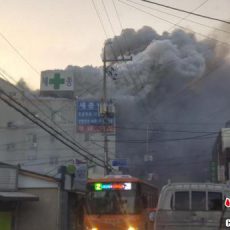在流行病和传染病学领域最常见的三个词:endemic, epidemic, pandemic经常被媒体和个人混淆,本文旨在简要讲解这三者之间的区别,并普及一些近期英文媒体上常见的相关词汇。
-
Endemic 最简单,(of a disease or condition) regularly found among particular people or in a certain area;重点是:belonging or native to a particular people or country.
准确的翻译是:地方病。例如某些地方由于水土问题导致的大脖子病,又如某个某个年龄段的少年儿童多发的chicken pox(水痘)或非洲某些地区流行的 malaria(疟疾)。
*注:中国古代小说中经常出现的所谓“瘴气”的医学本质就是 malaria(疟疾)。 -
Epidemic – An epidemic occurs when a disease affects a greater number people than
is usual for the locality or one that spreads to areas not usually
associated with the disease.
关键词是 spread.
An epidemic refers to the, often sudden, rise in the number of cases of a particular disease above the normal endemic level.
最近的例子是2003年的SARS.
准确的翻译是:流行病
-
Pandemic – When an epidemic spreads throughout the
world; A pandemic is an epidemic of world-wide proportions.
典型的例子是艾滋病,以及1918年的西班牙流感(Spanish influenza)。
准确的翻译是:全球流行病
下面是过去发生过的主要pandemic:
|
Pandemic |
Causative agent |
Date |
Deaths |
Comments |
| Spanish Flu | Influenza A virus | 1918-1919 | 50 million | Unlike seasonal flu, the young, fit and healthy were worst affected |
| The Great Plague | Yersinia pestis | Mid 1300s | 75-200 million | Got its alternative name “black death” thanks to the black patches that appeared on the skin of those infected |
| 6th Cholera Pandemic | Vibrio cholerae | 1899-1923 | 800,000 | Lessons learnt in earlier cholera pandemics meant the death toll was much lower than it otherwise might have been |
| Fiji Measles Pandemic | Rubeola virus | 1875 | 40,000 |
Fijian royalty took the disease back to their island following a visit to Australia where the disease was rife. Consequently, one-third of Fiji’s population died |
| Smallpox Pandemic | Variola virus | 1870-1874 | Over 500,000 |
Thought to be triggered by the Franco-Prussian war, incidence and fatality rates were notably lower in the UK attributed to the Vaccination Act of 1853 |
| Tuberculosis (TB) | Mycobacterium tuberculosis | Current | 1.6 million in 2017 | In 2017, 10 million people contracted TB. Multi-drug resistance remains a significant concern |
*上表摘自:https://www.technologynetworks.com/immunology/articles/epidemic-vs-pandemic-323471
究竟哪种疾病应该称为endemic, epidemic还是pandemic?这是流行病学/传染病学(Epidemiology)的工作,这个分类和定性称为“Disease Event Classification”.
这个分类主要参考关于疾病的两个参数:
- The pattern and speed by which a disease moves (known as the reproduction rate) 疾病传播方式和速度
-
The size of the susceptible population (known as the critical community size) 易感人群数量
根据一种疾病的诸多特征,传染病学可以将一种疾病定性为下列几种:
- Sporadic 偶发性
- Cluster 群组性,指发病人数多,但实际数量或成瘾尚不确定。例如化学工厂或核设施事故发生后,往往出现群组性癌症。
- Endemic 地方病
- Hyperendemic 超强地方病,指某一特定地区超高等级、顽固的疾病情况,例如非洲某些地区的艾滋病。
- Epidemic 流行病。传染病以指数方式散布,感染人数较多就称为流行病。
- Outbreak 爆发流行病
- Pandemic 全球流行病
希望以上注解能帮你理解这几个概念。
参考阅读:






